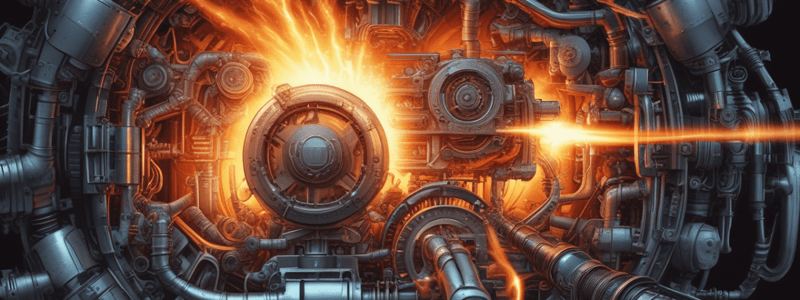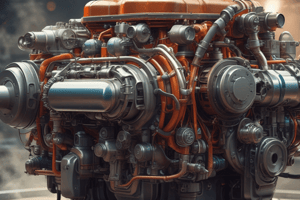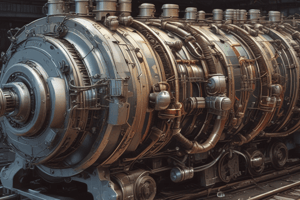Podcast
Questions and Answers
What is the first stage of combustion in a CI engine?
What is the first stage of combustion in a CI engine?
- Period of rapid combustion
- Ignition delay period (correct)
- Period of afterburning
- Period of controlled combustion
During which period in a CI engine is some fuel already admitted but has not yet ignited?
During which period in a CI engine is some fuel already admitted but has not yet ignited?
- Period of afterburning
- Period of rapid combustion
- Period of controlled combustion
- Ignition delay period (correct)
What does the ignition delay period influence in a CI engine?
What does the ignition delay period influence in a CI engine?
- Engine cooling system
- Exhaust pipe diameter
- Fuel tank capacity
- Combustion rate and knocking (correct)
What is the significance of the ignition delay period on engine performance?
What is the significance of the ignition delay period on engine performance?
When does the ignition delay period end in a CI engine's combustion process?
When does the ignition delay period end in a CI engine's combustion process?
What is defined as the time between fuel injection and actual burning in a CI engine?
What is defined as the time between fuel injection and actual burning in a CI engine?
What does point a represent in the context of ignition delay?
What does point a represent in the context of ignition delay?
Which type of fuel typically has a high physical delay?
Which type of fuel typically has a high physical delay?
What is the main factor that greatly reduces the physical delay during ignition?
What is the main factor that greatly reduces the physical delay during ignition?
During which delay period does the rate of heat-release reach its maximum?
During which delay period does the rate of heat-release reach its maximum?
What is essential for achieving efficient and clean combustion in a diesel engine?
What is essential for achieving efficient and clean combustion in a diesel engine?
Which design factor directly affects the duration of the delay period in a compression-ignition engine?
Which design factor directly affects the duration of the delay period in a compression-ignition engine?
Why does the minimum autoignition temperature of a fuel decrease with an increase in compression ratio?
Why does the minimum autoignition temperature of a fuel decrease with an increase in compression ratio?
What is the main role of the delay period in a diesel engine?
What is the main role of the delay period in a diesel engine?
What factor is NOT important in affecting the delay period?
What factor is NOT important in affecting the delay period?
What factor contributes to diesel knock due to the ignition of fuel in localized areas of the combustion chamber?
What factor contributes to diesel knock due to the ignition of fuel in localized areas of the combustion chamber?
How does an increase in engine speed affect the delay period in a diesel engine?
How does an increase in engine speed affect the delay period in a diesel engine?
What is the primary cause of diesel knock in a compression-ignition engine?
What is the primary cause of diesel knock in a compression-ignition engine?
How does an increase in engine output affect the air-fuel ratio and delay period?
How does an increase in engine output affect the air-fuel ratio and delay period?
What contributes to diesel knock related to injector issues in a compression-ignition engine?
What contributes to diesel knock related to injector issues in a compression-ignition engine?
Why is the Cetane number important in evaluating diesel fuel?
Why is the Cetane number important in evaluating diesel fuel?
How does high quality diesel fuel help in reducing diesel knock?
How does high quality diesel fuel help in reducing diesel knock?
'Diesel knock' can be described as what type of noise during the combustion process in a CI engine?
'Diesel knock' can be described as what type of noise during the combustion process in a CI engine?
'Diesel knock' is characterized by what occurrence in the engine cylinder?
'Diesel knock' is characterized by what occurrence in the engine cylinder?
'Cetane rating' focuses on evaluating the ignition quality of diesel fuel in comparison to what parameter for gasoline engines?
'Cetane rating' focuses on evaluating the ignition quality of diesel fuel in comparison to what parameter for gasoline engines?
What is the relationship between the Cetane number and ignition delay?
What is the relationship between the Cetane number and ignition delay?
Why is achieving a high Cetane number essential for diesel engines?
Why is achieving a high Cetane number essential for diesel engines?
How do high-Cetane fuels contribute to emissions control?
How do high-Cetane fuels contribute to emissions control?
What role does fuel quality play in determining the Cetane number?
What role does fuel quality play in determining the Cetane number?
What issue can arise from extremely high Cetane numbers in diesel fuels?
What issue can arise from extremely high Cetane numbers in diesel fuels?
Why is efficient mixing of air and fuel crucial in the combustion chamber of a CI engine?
Why is efficient mixing of air and fuel crucial in the combustion chamber of a CI engine?
Why does a CI engine require a high compression ratio?
Why does a CI engine require a high compression ratio?
Why must the combustion chamber be robustly constructed in a CI engine?
Why must the combustion chamber be robustly constructed in a CI engine?
How do the shape and geometry of the combustion chamber influence combustion in a CI engine?
How do the shape and geometry of the combustion chamber influence combustion in a CI engine?
Why is it important for the combustion chamber design to be compatible with the engine's ignition system?
Why is it important for the combustion chamber design to be compatible with the engine's ignition system?
What is the purpose of generating turbulence in the combustion chamber of internal combustion engines?
What is the purpose of generating turbulence in the combustion chamber of internal combustion engines?
Which design element plays a critical role in shaping the combustion process within the combustion chamber?
Which design element plays a critical role in shaping the combustion process within the combustion chamber?
What is the primary function of a pre-chamber design in internal combustion engines?
What is the primary function of a pre-chamber design in internal combustion engines?
How do modern engines utilize direct injection to enhance combustion efficiency?
How do modern engines utilize direct injection to enhance combustion efficiency?
Which element is crucial in dissipating heat effectively within the combustion chamber to prevent engine damage?
Which element is crucial in dissipating heat effectively within the combustion chamber to prevent engine damage?
In what way does squish contribute to enhancing turbulence in the combustion chamber?
In what way does squish contribute to enhancing turbulence in the combustion chamber?
How does a piston bowl design influence turbulence within the combustion chamber?
How does a piston bowl design influence turbulence within the combustion chamber?
What role does jet and direct injection play in promoting turbulence in modern engines?
What role does jet and direct injection play in promoting turbulence in modern engines?
What is the purpose of Bowl-in-piston designs in diesel engines?
What is the purpose of Bowl-in-piston designs in diesel engines?
How do Variable Valve Timing (VVT) systems influence combustion efficiency?
How do Variable Valve Timing (VVT) systems influence combustion efficiency?
What is the main function of a Variable Geometry Intake System?
What is the main function of a Variable Geometry Intake System?
How does Turbulent Jet Ignition (TJI) technology contribute to combustion in engines?
How does Turbulent Jet Ignition (TJI) technology contribute to combustion in engines?
What is the purpose of Exhaust Gas Recirculation (EGR) in engines?
What is the purpose of Exhaust Gas Recirculation (EGR) in engines?
What is a characteristic of Direct-Injection Chambers in compression ignition engines?
What is a characteristic of Direct-Injection Chambers in compression ignition engines?
What is a drawback of Shallow Depth Chambers in large engines?
What is a drawback of Shallow Depth Chambers in large engines?
How does an Indirect-Injection Chamber differ from a Direct-Injection Chamber?
How does an Indirect-Injection Chamber differ from a Direct-Injection Chamber?
What is the main function of a Swirl Chamber in an engine?
What is the main function of a Swirl Chamber in an engine?
What is the significance of EGR (Exhaust Gas Recirculation) system when it comes to the composition of the air-fuel mixture?
What is the significance of EGR (Exhaust Gas Recirculation) system when it comes to the composition of the air-fuel mixture?
Flashcards are hidden until you start studying
Study Notes
Combustion Chamber Design in CI Engines
- The combustion chamber design must meet multiple requirements to achieve efficient, clean, and reliable combustion
- Key factors:
- Arrangement of fuel injectors and glow plugs
- Heat management
- Emission control
- Piston-bowl design
- Fuel injection system integration
- Adaptability to varied operating conditions
Methods of Generating Turbulence in Combustion Chamber
- Swirl: introducing a swirling motion to the incoming air-fuel mixture
- Tumble: creating a vertical or axial swirling motion within the combustion chamber
- Squish: designing the combustion chamber to promote a squishing or squeezing effect on the air-fuel mixture
- Jet and Direct Injection: using high-velocity fuel jets to create turbulence in the air
- Pre-Chamber Design: using a small chamber adjacent to the main combustion chamber
Ignition Delay Period
- The time between the start of fuel injection and the actual ignition of the fuel-air mixture
- Factors affecting delay period:
- Compression ratio
- Engine speed
- Output
- Fuel atomization
- Combustion chamber design
Period of Rapid Combustion
- The phase in which the pressure rise is rapid
- During this period, most of the fuel admitted would have evaporated and formed a combustible mixture with air
- The rate of heat release is maximum during this period
Types of Combustion Chambers for CI Engines
- Direct-Injection Chambers:
- Open combustion chamber with a flat cylinder head and a cavity in the piston crown
- Advantages: minimum heat loss, no cold starting problems, fine atomization
- Drawbacks: high fuel-injection pressure required, complex design of fuel injection pump
- Shallow Depth Chamber:
- Used for large engines running at low speeds
- Cavity diameter is very large, resulting in negligible squish
- Indirect-Injection Chambers:
- Swirl Chamber: a spherical-shaped chamber separated from the engine cylinder
- Divided combustion chamber with restricted passages
Stages of Combustion in CI Engines
-
Ignition Delay Period
-
Period of Rapid Combustion
-
Period of Controlled Combustion
-
Period of Afterburning### Cetane Number and Diesel Engine Performance
-
A higher Cetane number results in a shorter ignition delay, promoting quicker and more complete combustion in diesel engines.
-
Higher Cetane numbers lead to improved ignition characteristics, resulting in better cold-start performance, reduced engine noise, and lower emissions.
-
Engines running on high-Cetane fuels exhibit smoother operation, lower particulate matter, and nitrogen oxides, contributing to cleaner air and compliance with environmental regulations.
-
Refineries control the refining process to produce diesel fuels with specific Cetane ratings, and additives can enhance the Cetane number of lower-quality diesel fuels.
-
A higher Cetane number is generally desirable, but extremely high Cetane numbers may lead to faster combustion, causing issues like engine knock or increased emissions of nitrogen oxides.
Combustion Chamber Requirements for CI Engines
Efficient Combustion Chamber Design
- The combustion chamber must facilitate the thorough mixing of air and fuel to create a homogenous mixture for uniform and controlled combustion.
- A high compression ratio is required to elevate the air temperature within the combustion chamber, promoting better combustion efficiency and thermal efficiency.
Robust Combustion Chamber Construction
- The combustion chamber must be robustly constructed to withstand high pressures and temperatures associated with the combustion process.
- Durable materials and effective cooling mechanisms are employed to ensure the longevity and reliability of the combustion chamber.
Combustion Chamber Shape and Geometry
- The shape and geometry of the combustion chamber influence turbulence, swirl, and squish patterns during combustion, impacting combustion speed, heat distribution, and pollutant formation.
- Design considerations aim to achieve an optimum balance between these parameters for efficient and clean combustion.
Ignition System Compatibility
- The combustion chamber design should be compatible with the engine's ignition system.
Studying That Suits You
Use AI to generate personalized quizzes and flashcards to suit your learning preferences.





